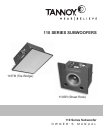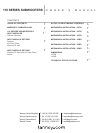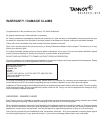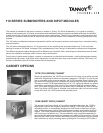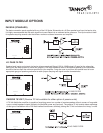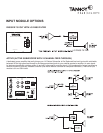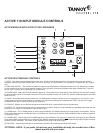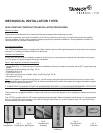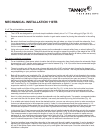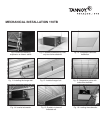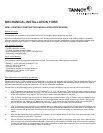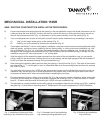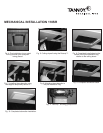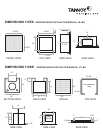
MECHANICAL INSTALLATION 110TB
2’ x 2’ Tile grid installation procedures:
1) The 110TB was designed for quick and simple installation directly into a 2’ x 2’ T-bar ceiling grid (Figs. 9 & 10).
2) Remove several tiles around the installation location to gain easier access for placing the subwoofer in the ceiling
grid.
3) Be certain that there is sufficient hanger wire suspending the grid where you intend to install the subwoofer. If not,
it may be necessary to add additional grid hanger wires around the perimeter of the location, as required. We
recommend a minimum of four per sub location, located on the main grid support bar within four inches of each of
the four corners of the subwoofer.
4) Using wire rope or chain, select opposing corners on the subwoofer to connect safety lines, or seismic tethers (Fig.
8 & 9) securely to the structure. These lines should be taut enough to support the majority of the weight of the 110TB,
yet leave enough load against the ceiling grid to prevent the grid from buzzing. Be sure all tether points are securely
fastened to the subwoofer and anchored securely to the substructure of the building.
Free space installation procedures:
1) For an installation in free space, select a location that will allow suspension from directly above the subwoofer. Begin
by measuring a 19.5” square, and at each corner install a fastener (Fig. 11 & 12) such as the recommended hanger
bolt to support each corner of the subwoofer.
2) Thread a coupling nut all the way over a hanger bolt and with a 9/16” socket set, start threading the hanger bolt
into the support structure. Secure a hanger to a substructure at all four corners. This may be accomplished several
ways depending on your particular installation.
3) Back off the coupling nut completely (Fig. 11) and thread on a backing nut with which to lock threads to the coupler.
Hold the coupler up to the hanger bold to estimate the half way point of the coupler and set the backing nut to that
height before re-installing the coupler and tightening it in place with a socket and an open end wrench. Thread a
backing nut onto the threaded rod (or an eyebolt) far enough so the rod can be threaded into the coupler until it
stops, having reached the hanger bolt inside. Now tighten up the backing nut on the rod to secure it from turning,
until it looks like (Fig. 4). Remember that the rod could otherwise be an eyebolt, if you are using the wire rope
suspension method, or a Hilti™ type fastener. Be sure to follow local building codes.
4) Always install and utilize all four points and it should look like (Fig. 13). In this photo, the turnbuckles have been
added to the ends of the rods. The closed eyebolt on the turnbuckle has been removed and replaced with the
threaded rod. Note that the turnbuckle is stamped with an “L” to identify the load or live end. Observe the correct
assembly procedure from rod to eye-hook.
5) Now it is a fairly simple procedure to place the subwoofer onto the awaiting hooks. Two people, on separate ladders
can now hoist the sub into place. When installed, it can easily be leveled by turning the turnbuckles (Fig. 14).
6) If no suitable point exists directly above the desired location, you can use wire rope or chain to make connections
that are not perpendicular to the suspension point(s). Under no circumstances should the angles exceed +/- 15
degrees from vertical. Make certain that you follow closely the instructions and regulations for the use of wire rope
for overhead suspension. Serious injury could result if guidelines and safety margins are not closely obeyed.
7) In this photo (Fig. 15) we have removed the threaded rod and installed eyebolts with backing nuts into the couplers,
as described earlier. Detail of the connection with wire rope is shown in (Fig. 8), which is identical top and bottom.
Take measurements to approximate the lengths of rope you will need. It might be convenient to make some or
perhaps all of your wire ropes on the ground and use a quick link (Fig. 7) on each end to connect between both
the suspension point and at the subwoofer. Again, it is important to follow local code and regulations for use of wire
rope in overhead suspension. Check with your supplier for additional instructions on its use.
8) Once two installers have raised the subwoofer to the ropes and the sub is safely suspended, it can be leveled by
adjusting the rope lengths. Check for even tension on all ropes, and note that it is much easier to let some wire
slip out of the tighter ropes, rather than trying to pull up and tighten the loose ropes. Once the subwoofer is level,
installation is complete.



